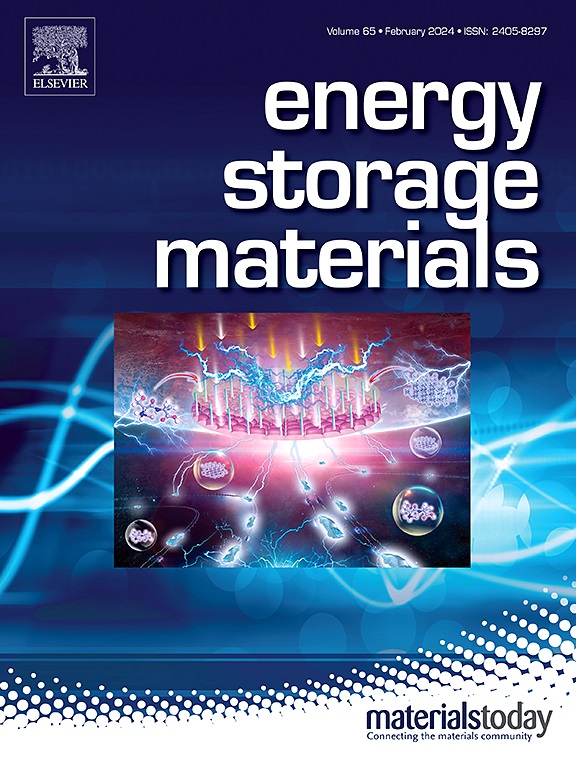Dynamic iron migration triggers single-to-dual electron redox conversion in hexacyanoferrates for stable aqueous potassium ion batteries
IF 18.9
1区 材料科学
Q1 CHEMISTRY, PHYSICAL
引用次数: 0
Abstract
Metal hexacyanoferrate-based cathodes (HCFs) with tunable redox potentials, low cost, and high capacity are ideal for aqueous potassium ion batteries (AKIBs). However, vacancies and the high diffusivity of water in aqueous electrolytes drain metal ions in HCFs, decreasing the discharge capacity and structure integrity during cycling. To address these problems, an electrochemically induced rectification strategy is applied through a Fe ion electrolyte additive. Nickel hexacyanoferrate is selected as a model cathode. Pre- and post-cycling in the modified electrolyte (ME) revealed that the surface vacancies of the K1.80Ni[Fe(CN)6]0.7498·2·51 H2O (KNiHCF) are in-situ replenished with electroactive Fe ions and form a double-redox HCFs, resulting in enhanced conductivity and discharge capacity. Moreover, owing to the surface vacancy replenishment and gradient formation, the dissolution of KNiHCF in ME is decelerated. The resultant KNiHCF-ME cathode exhibits excellent rate performance (7000 mA g-1) and cycling stability for both half (98.50 % after 1000 cycles at 1000 mA g-1) and full (80.08 % after 5000 cycles at 2000 mA g-1) cells. Moreover, similar findings have been observed for the KCuHCF and KCoHCF electrodes, demonstrating the universality of this strategy. This study contributes to the possible solution of defective HCFs with surface vacancies, which may be extended to other cathodes for AKIBs.


动态铁迁移触发稳定钾离子电池中六氰高铁酸盐的单到双电子氧化还原转换
金属六氰铁酸盐阴极(HCFs)具有可调的氧化还原电位、低成本和高容量,是水性钾离子电池(akib)的理想材料。然而,水电解质中的空位和水的高扩散率会使氢氯氟烃中的金属离子流失,从而降低了循环过程中的放电容量和结构完整性。为了解决这些问题,采用了一种电化学诱导整流策略,通过铁离子电解质添加剂。选择六氰高铁镍作为模型阴极。在改性电解质(ME)中循环前后,发现K1.80Ni[Fe(CN)6]0.7498·2.51H2O (KNiHCF)的表面空位被电活性铁离子原位补充,形成双氧化还原hcf,提高了导电性能和放电容量。此外,由于表面空位的补充和梯度的形成,KNiHCF在ME中的溶解速度减慢。所得的KNiHCF-ME阴极具有优异的倍率性能(7000 mA g-1)和半电池(1000 mA g-1循环后98.50%)和全电池(5000 mA g-1循环后80.08%)的循环稳定性。此外,在KCuHCF和KCoHCF电极上也观察到了类似的结果,证明了这种策略的普遍性。该研究有助于解决具有表面空缺的缺陷HCFs,并可扩展到其他akib阴极。
本文章由计算机程序翻译,如有差异,请以英文原文为准。
求助全文
约1分钟内获得全文
求助全文
来源期刊

Energy Storage Materials
Materials Science-General Materials Science
CiteScore
33.00
自引率
5.90%
发文量
652
审稿时长
27 days
期刊介绍:
Energy Storage Materials is a global interdisciplinary journal dedicated to sharing scientific and technological advancements in materials and devices for advanced energy storage and related energy conversion, such as in metal-O2 batteries. The journal features comprehensive research articles, including full papers and short communications, as well as authoritative feature articles and reviews by leading experts in the field.
Energy Storage Materials covers a wide range of topics, including the synthesis, fabrication, structure, properties, performance, and technological applications of energy storage materials. Additionally, the journal explores strategies, policies, and developments in the field of energy storage materials and devices for sustainable energy.
Published papers are selected based on their scientific and technological significance, their ability to provide valuable new knowledge, and their relevance to the international research community.
 求助内容:
求助内容: 应助结果提醒方式:
应助结果提醒方式:


